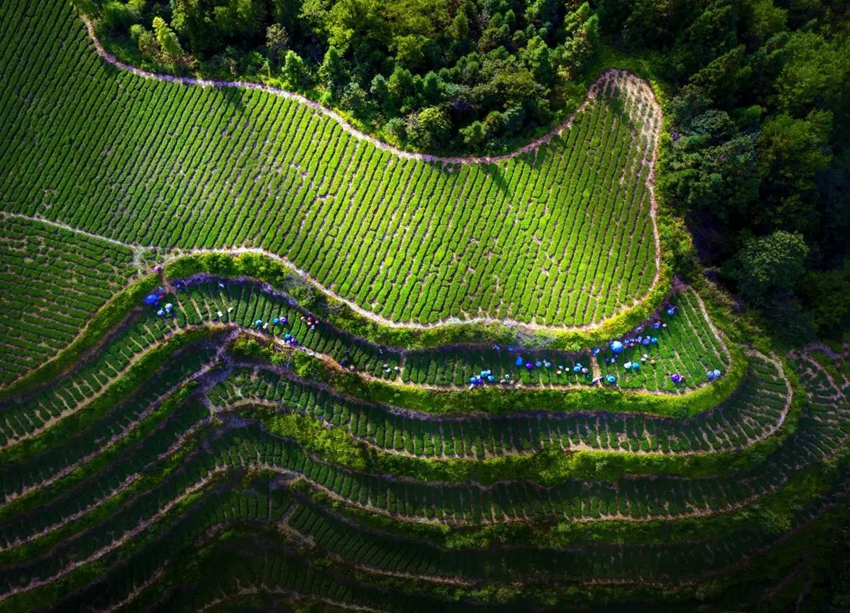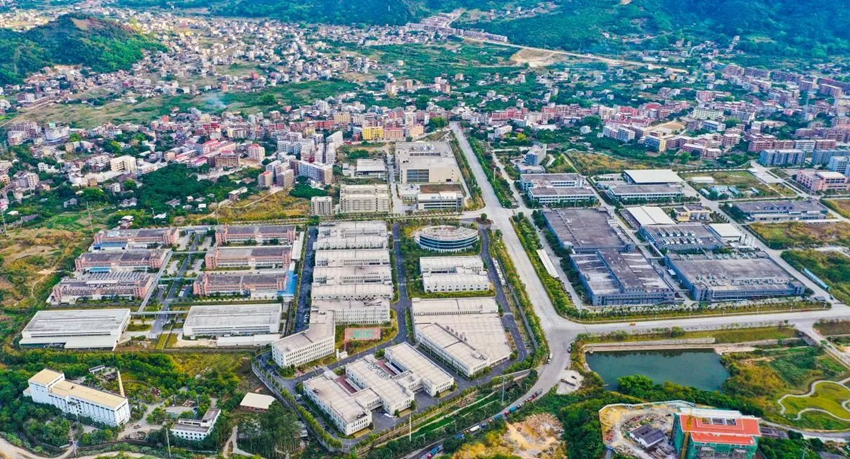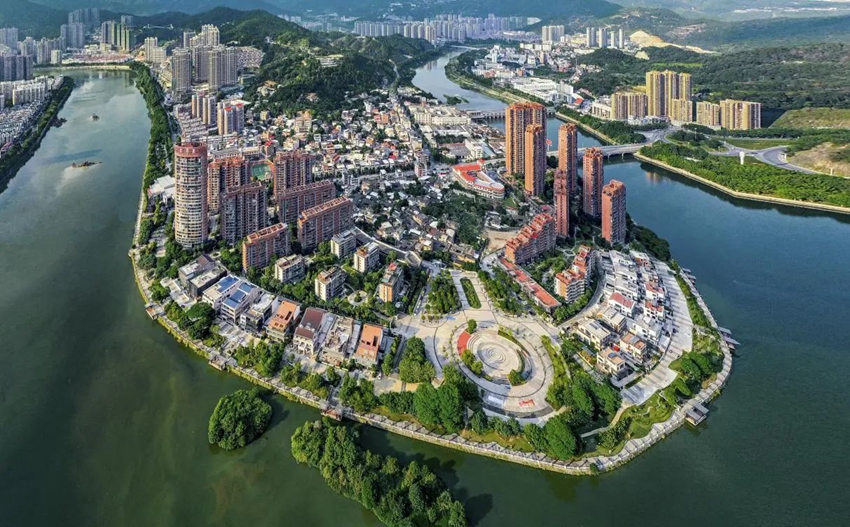- Industry
- Hubs
Anxi County, located in Quanzhou, Fujian Province, is historically famous for its tea production. During the "autumn tea season" this year, large quantities of high-quality Anxi Tieguanyin tea have been listed, with daily trade volumes reaching up to 100,000 jin (about 50 tons).
Looking up from the vast tea gardens, the "Anxi Tieguanyin No. 1" remote sensing satellite, the first of its kind named after tea in China, monitors tea cultivation, tree growth, soil, and environmental conditions from 535 kilometers above. This satellite plays a key role in ensuring the abundant harvest of the next spring tea season.

Anxi Tea Farmers at Work (Image by Chen Dashui)
It is hard to imagine that nearly 40 years ago, Anxi was one of the largest poverty-stricken counties in Fujian Province. In 1985, the average annual income for farmers was only 270 yuan, with one-third of the population struggling to meet basic needs. At that time, tea farmers walking the mountain roads, carrying bamboo baskets to sell tea, could never have imagined that their Tieguanyin tea would one day become a highly esteemed symbol of Anxi.
Recently, the "2024 China Small and Medium Cities High-Quality Development Index" was released, with Anxi ranking 50th among the nation's top 100 counties by overall strength and securing a spot among the top 10 counties for investment potential. This is not the first time Anxi has broken into the national "top 100."
How did this poverty-stricken county reach the "top 50"?
From "Tea Trade City" to Reality
In 1995, Anxi capitalized on its signature "Tieguanyin" tea, expanding its local tea industry by building on the region's unique advantages. This success helped the county shake off its poverty label.
As the new century began, Anxi Tieguanyin encountered bottlenecks. With the increasing variety of tea products available nationwide, the dominance of Tieguanyin was challenged.

Autumn in the Tea Gardens (Image by Chen Wei)
"The turning point came about a decade ago when e-commerce arrived in Anxi," recalls Zhang Bingcan, Deputy Director of the Anxi Tea Industry Management Committee. Since then, online tea sales have surged, and Peace Bai Tea (Fujian) Supply Chain Management Co. Ltd. (hereafter referred to as Peace Bai Tea) became one of the pioneers driving Anxi's tea industry transformation.
Peace Bai Tea integrates the entire tea production chain—sourcing, production, packaging, logistics, and after-sales services—mirroring Anxi's broader efforts to consolidate its tea industry into a complete value chain.

Anxi Tea Gardens (Image by Zhuo Fangbin)
Today, Anxi boasts 600,000 acres of tea gardens, producing and selling 300,000 tons of tea annually—accounting for one-tenth of China's total tea production. The county's tea trade volume leads the nation's county-level markets. Anxi has transitioned from focusing solely on Tieguanyin to cultivating a diverse tea industry, realizing its goal of becoming a "Tea Trade City."
Billion-Dollar Optoelectronics Industry "Starting from Scratch"
Building on the success of its tea industry, Anxi has strategically branched out into the optoelectronics industry, creating an entire industrial chain that includes substrate materials, chips, packaging, and applications. Despite starting from scratch, Anxi has quickly grown its optoelectronics sector through the establishment of major companies like Jing'an Optoelectronics, a global leader in sapphire substrate manufacturing.

Jing'an Optoelectronics Production Line (Image by Li Weiwei)
"Anxi's geographical location is a significant advantage. It not only borders four cities and six counties but also sits at the heart of the Xiamen-Zhangzhou-Quanzhou metropolitan area, which gives it unique developmental potential," said Wu Mingdeng, Deputy Director of the Quanzhou Chip Valley Anxi Sub-park.
After Jing'an Optoelectronics set up in Anxi, the region leveraged its location to attract over 15 upstream and downstream companies, fostering the development of a semiconductor lighting industry cluster and the emergence of the Quanzhou Chip Valley Anxi Sub-park.

Quanzhou Chip Valley Anxi Sub-park (Image provided by the Anxi County Propaganda Department)
The industrial cluster has led to the concentration of resources, such as equipment and labor. "Even within the park, two of our clients manufacture computers, and we supply them with parts, significantly reducing logistics costs," said Xie Dong, the manager of Zhengxin Optoelectronics, a new tenant of the park.
In 2023, Anxi's optoelectronics sector reached an industrial output value of 14.8 billion yuan. "Looking ahead, we plan to attract 1-3 leading companies in the industry to further strengthen the sector," said Wu Mingdeng confidently.
Comprehensive Services Promote Mutual Success
"Our factories and R&D centers are based in Pingxiang, Jiangxi, and Shenzhen, Guangdong. When we decided to expand, we chose to settle in Anxi, where the optoelectronics industry is flourishing," said Xie Dong of Zhengxin Optoelectronics, recalling the company's visit to Anxi in July. The meeting quickly led to a partnership, with the local government providing support through a coordinated, regular consultation mechanism. Within a month, Zhengxin's new factory was under construction.
The smooth collaboration between Anxi and the company is attributed to the county's comprehensive service system. "Anxi's regular coordination mechanism involves a dedicated project task force, along with the Investment Promotion Office,Preparation Office), and Key Office, all working together to address practical challenges and ensure smooth operations," said Xu Qishu, Director of the Anxi Investment Promotion Office.

Anxi at Night (Image by Lin Sihong)
This year, Anxi's local government has made significant efforts to attract investments, conducting 28 promotional events in cities like Hong Kong, Yunnan, Shanghai, Beijing, and Jiangsu, as well as holding 10 investment roadshows. They've also carried out overseas trade promotions in 14 countries. According to Xu Qishu, direct communication with potential investors is more cost-effective and efficient compared to using intermediaries.
In the first half of the year, Anxi signed 92 projects with a total investment of 46.845 billion yuan, further solidifying its status as a prime investment destination.

Modern Anxi County (Image by Chen Rongchun)
"Industry is the core engine and key support for Anxi's development," said Wu Yuzhou, Secretary of the Anxi County Party Committee. "We will continue to strengthen our industries, integrating the eight major industrial chains, and push forward towards the goal of building a modern medium-sized city with distinct tea culture."
Source | People's Daily, Anxi County Government Office
